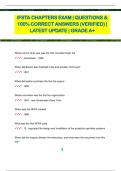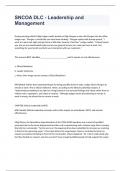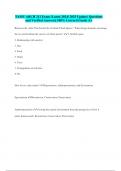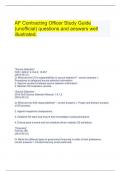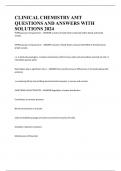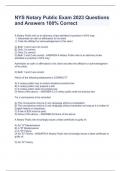Samenvatting IDM Midterm
Information systems (IS) have multiple definitions:
- The set of interrelated components that collect, process, store, and distribute
information to support decision making and control in an organization.
- Combinations of hardware, software, and telecommunications networks that people
build and use to collect, create etc. typically in organizational settings.
- The interrelated components work together to collect, process, store information to
support activities in an organization.
The five components of IS:
- Hardware: tangible portion of information systems. E.g., computers.
- Software: comprises the set of instructions for the hardware. It is intangible. The two
main categories for the software are: Operating-system software, makes the hardware
usable. And the second one is Application software, does something useful, like
Microsoft Excel.
- Data: the collection of facts. When data is combined it can be a powerful tool.
- People and Process: process is a series of steps to achieve a goal.
One of the main roles of information systems is to change data into information and then
transform the information into organizational knowledge.
How have information systems changed over the years?
- The mainframe era: late 1950s – 1960s. Computers were seen to do calculations
more efficiently. “time-sharing’ allowed dozens or even hundreds of users to
simultaneously access mainframe computers from the same building or miles away.
The manufacturing resources planning (MRP) systems were introduced in the late
1960s, which gave companies the ability to manage the manufacturing process.
- The PC revolution: in 1975, the first computer was announced. At first it was a very
expensive product, but it was easy for competitors to copy. So, in 1980s, there were
less expensive versions comping up. It was not connected to a network.
- Client server: In the mid 1980s, businesses began to see the need to connect their
computers together to collaborate and share resources. This is known as “Client
servers”. With connecting to a server, several PCs log in to a Local Area Network
(LAN). The first Enterprise Resource Planning (ERP) systems were developed and
run on the client-server architecture. An ERP can be used for the entire business.
- The World Wide Web and E-Commerce: The internet was invented in 1969, but it
was not usable for businesses except for emailing. In 1989, the world wide web was
invented, becoming the catalyst for growth of the internet. In 1991, the restrictions for
commercial use of the internet were lifted.
- Web 2.0: a new type of interactive website, where you did not know how to create a
web page or do any programming to put information online, led to disintermediation.
- The Post-PC World: the sales of PC are beginning to decline as sales of smartphones
and tablets are beginning to rise.
The operating system...
- Tells the hardware what to do
- Provides the user-interface components
- Provides a platform for software developers to write applications
, Application software is utilized directly today to accomplish a specific goal such as word
processing, calculations, and surfing.
A “killer” application is one that becomes so essential that large numbers of people will buy a
device just to run that application.
Productivity software allows office employees to complete their daily work efficiently.
- Word processing: Users can create and edit documents using this class of software.
- Spreadsheet: Provides a way to do numeric calculations and analysis in rows and
columns.
- Presentation
The Integrated development environment (IDE), most of these programs provide developers
with an environment in which they can write the code, test it, and convert/compile it into the
format that can be run on a computer. This is called a utility software.
The Enterprise Resource Planning (ERP) system was developed to bring together an entire
organization in one program. ERP software utilizes a central database that is implemented
throughout the entire organization.
- A software application: ERP is an application that is used by many of an
organization’s employees.
- Utilizes a central database: All users of the ERP edit and save their information
form the same data source.
- Implemented organization-wide: ERP systems include functionality that covers all
essential components of a business.
A Customer Relationship Management (CRM) system manages an organization’s
customers. CRM can allow a business to personalize its relationship with each of its
customers.
Links in supply chain: N suppliers x N manufacturing facilities x N distributors
A SCM system handles the interconnection between these links as well as the inventory of
the products in the various stages of development.
Advantages of Cloud computing:
- No software to install
- Available every time
- For everyone
- It is quick
- Whenever you need it
- Information will be online forever
- Not limited by the memory of your computer
Disadvantages
- Your information is sight table for everyone
- You must have internet to access
- You are relying on third parties
Virtualization is the process of using software to stimulate a computer or some other device
to reduce the number of servers that is needed to provide the necessary services.
Information systems (IS) have multiple definitions:
- The set of interrelated components that collect, process, store, and distribute
information to support decision making and control in an organization.
- Combinations of hardware, software, and telecommunications networks that people
build and use to collect, create etc. typically in organizational settings.
- The interrelated components work together to collect, process, store information to
support activities in an organization.
The five components of IS:
- Hardware: tangible portion of information systems. E.g., computers.
- Software: comprises the set of instructions for the hardware. It is intangible. The two
main categories for the software are: Operating-system software, makes the hardware
usable. And the second one is Application software, does something useful, like
Microsoft Excel.
- Data: the collection of facts. When data is combined it can be a powerful tool.
- People and Process: process is a series of steps to achieve a goal.
One of the main roles of information systems is to change data into information and then
transform the information into organizational knowledge.
How have information systems changed over the years?
- The mainframe era: late 1950s – 1960s. Computers were seen to do calculations
more efficiently. “time-sharing’ allowed dozens or even hundreds of users to
simultaneously access mainframe computers from the same building or miles away.
The manufacturing resources planning (MRP) systems were introduced in the late
1960s, which gave companies the ability to manage the manufacturing process.
- The PC revolution: in 1975, the first computer was announced. At first it was a very
expensive product, but it was easy for competitors to copy. So, in 1980s, there were
less expensive versions comping up. It was not connected to a network.
- Client server: In the mid 1980s, businesses began to see the need to connect their
computers together to collaborate and share resources. This is known as “Client
servers”. With connecting to a server, several PCs log in to a Local Area Network
(LAN). The first Enterprise Resource Planning (ERP) systems were developed and
run on the client-server architecture. An ERP can be used for the entire business.
- The World Wide Web and E-Commerce: The internet was invented in 1969, but it
was not usable for businesses except for emailing. In 1989, the world wide web was
invented, becoming the catalyst for growth of the internet. In 1991, the restrictions for
commercial use of the internet were lifted.
- Web 2.0: a new type of interactive website, where you did not know how to create a
web page or do any programming to put information online, led to disintermediation.
- The Post-PC World: the sales of PC are beginning to decline as sales of smartphones
and tablets are beginning to rise.
The operating system...
- Tells the hardware what to do
- Provides the user-interface components
- Provides a platform for software developers to write applications
, Application software is utilized directly today to accomplish a specific goal such as word
processing, calculations, and surfing.
A “killer” application is one that becomes so essential that large numbers of people will buy a
device just to run that application.
Productivity software allows office employees to complete their daily work efficiently.
- Word processing: Users can create and edit documents using this class of software.
- Spreadsheet: Provides a way to do numeric calculations and analysis in rows and
columns.
- Presentation
The Integrated development environment (IDE), most of these programs provide developers
with an environment in which they can write the code, test it, and convert/compile it into the
format that can be run on a computer. This is called a utility software.
The Enterprise Resource Planning (ERP) system was developed to bring together an entire
organization in one program. ERP software utilizes a central database that is implemented
throughout the entire organization.
- A software application: ERP is an application that is used by many of an
organization’s employees.
- Utilizes a central database: All users of the ERP edit and save their information
form the same data source.
- Implemented organization-wide: ERP systems include functionality that covers all
essential components of a business.
A Customer Relationship Management (CRM) system manages an organization’s
customers. CRM can allow a business to personalize its relationship with each of its
customers.
Links in supply chain: N suppliers x N manufacturing facilities x N distributors
A SCM system handles the interconnection between these links as well as the inventory of
the products in the various stages of development.
Advantages of Cloud computing:
- No software to install
- Available every time
- For everyone
- It is quick
- Whenever you need it
- Information will be online forever
- Not limited by the memory of your computer
Disadvantages
- Your information is sight table for everyone
- You must have internet to access
- You are relying on third parties
Virtualization is the process of using software to stimulate a computer or some other device
to reduce the number of servers that is needed to provide the necessary services.



